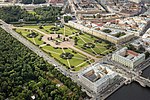The Field of Mars (Russian: Ма́рсово по́ле, tr. Marsovo Polye) is a large square in the centre of Saint Petersburg. Over its long history it has been alternately a meadow, park, pleasure garden, military parade ground, revolutionary pantheon and public meeting place.
The space now covered by the Field of Mars was initially an open area of swampy land between the developments around the Admiralty, and the imperial residence in the Summer Garden. It was drained by the digging of canals in the first half of the eighteenth century, and initially served as parkland, hosting a tavern, post office and the royal menagerie. Popular with the nobility, several leading figures of Petrine society established their town houses around the space in the mid eighteenth century. Under Peter the Great it was laid out with paths for walking and riding, and hosted military parades and festivals. During this period, and under Peter's successors it was called the "Empty Meadow" and the "Great Meadow". Empresses Anna and Elizabeth built their Summer Palaces here, and it was redeveloped into a pleasure park with pavilions and walkways for promenading. Theatres were built on the land during this period, and with the imperial patronage, the square became the "Tsaritsyn Meadow". New townhouses and palaces developed along the square's boundaries and across its frontage onto the Neva. During the reigns of Emperor Paul I and his son Alexander I, the square took on more of a martial purpose, with the construction of military monuments in the late eighteenth and early nineteenth centuries. In acknowledgement of this, and its role in hosting military reviews and parades, it was renamed the "Field of Mars" in 1805.
The square was part of the further development of the area by architect Carlo Rossi in the late 1810s, involving new buildings around the perimeter, and the extension of streets and frontages. During the nineteenth century the Field of Mars alternately hosted large military reviews, and public festivals. Sports and other leisure activities took place into the early twentieth century. After February 1917 the square became the ceremonial burial place of a number of those killed during the February Revolution. Construction of a memorial, the Monument to the Fighters of the Revolution, took place between 1917 and 1919 at the centre of the Field of Mars. The monument became the centre of an early pantheon of those who died in the service of the nascent Soviet state, and burials of some of the dead of the October Revolution and the Russian Civil War, as well as prominent figures in the government, took place between 1917 and 1933. Between 1918 and 1944 the Field of Mars was renamed the "Victims of the Revolution Square". The square was laid out with vegetable gardens to help feed the city during the siege of Leningrad, and also hosted an artillery battery. Restorations took place after the war, including the installation of the first eternal flame in Russia. In the post-Soviet period the Field of Mars has become a popular location for demonstrations and protests.











